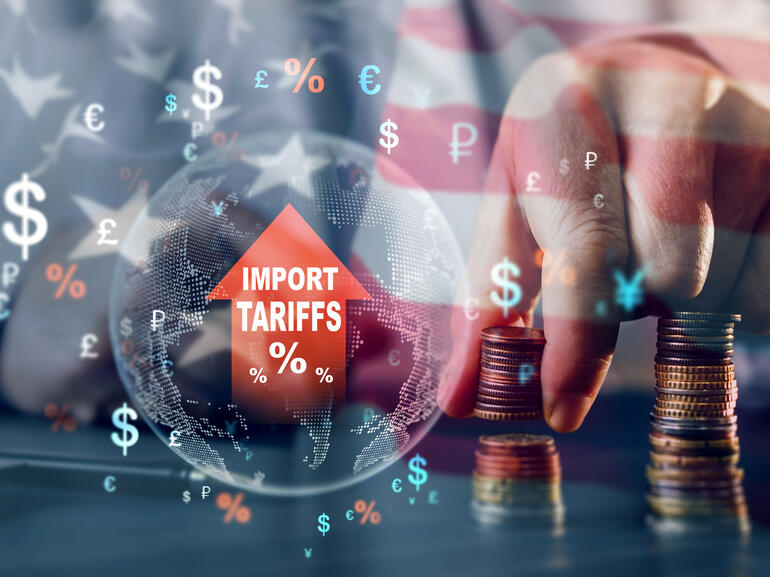Market Update Letter: The Economy, Trump 2.0 and the Resilience of Commercial Real Estate
Northmarq Fund Management Research

Overview
We are investment managers and intend to stay in our lane. Therefore, this letter is not about politics; rather, it’s about policies, and how recent and upcoming Executive actions may on balance be challenging for the economy in the short term, but paradoxically could prove beneficial for many commercial real estate investments. For the purposes of this analysis, we’re not focused on what Trump should do, we’re focused on what he might or will do. Within these guardrails, it would be a mistake to view new Trump Administration policies as uncoordinated chaos. That was the first term. This time around, there are clear goals and themes, and a much more organized and experienced team on board to effectuate big changes. Nevertheless, the fact that there’s a clear strategy does not mean that the tactics and the outcomes won’t be unpredictable and unnerving. In fact, the policies being pursued against sclerotic institutions such as the Federal government, post-war international alliances, and a dangerously unbalanced global trading system, are so aggressive and so bold that extreme stock/bond market volatility must be expected.
What can we glean from market reactions to the proposed new tariff system? Among many others, the following are some of the popular theories floating around this week: Are foreigners selling Treasuries out of need or spite? Is it a blowup of the hedge fund “basis trade”? Is it caused by the unwinding of equity hedges? What about the big upcoming auctions of U.S Treasuries? Are investors so fearful that they’re selling high quality assets and moving to cash?
Many of these possible explanations highlight a highly leveraged financial system, an aging set of alliances and trading partnerships, and government and regulatory systems in need of reform. These systems are facing a paradigm shift and change agent in the form of a second Trump Administration. The tariffs may have been the catalyst, but they alone are not sufficient to explain the magnitude of this week’s volatility. When combined with other policies and other global events, investors seem to be undergoing a reevaluation of market risk, return and liquidity. These trends, while highly disruptive in the short run, particularly in form of interest rate uncertainty, have the potential to become beneficial to commercial real estate and other hard assets. Anchoring investment allocations to a slower-moving market that produces income backed by a durable form of value, may ultimately prove appealing amidst these macro changes.
Trump 2.0 Strategy
Treasury Secretary Scott Bessent (an experienced hedge fund manager) is currently a key figure in crafting economic policy. He has made several critical objectives known. Secretary Bessent wants to alter the debt trajectory to achieve a reduction from today’s 120%+ ratio of Federal debt to GDP—currently on track for 133% by 2033—down to a more manageable 100% debt-to-GDP ratio. As we indicated in our annual reports, we believe the 2020 to 2024 rise in the debt-to GDP ratio from 105.8% to 120.7% reduces the GDP growth potential of the economy by 0.25% per year, adding 30 years to the total required for the economy to repay the Federal debt. As an initial step, Bessent’s focus has been on bringing down Treasury yields. In the post-Covid phase, Janet Yellen chose to issue massive sums of short-term bonds, rather than lock up low interest rates for longer. This resulted in an unusually high $9 trillion of outstanding federal debt maturing in 2025. Bessent would rather issue new bonds at 4% (or lower). A 100-basis-point (1%) reduction in average Treasury rates during 2025 would save about $900 billion in annual interest cost. Next, approximately $600 billion of CRE loans mature this year, along with nearly $1 trillion of corporate bonds and a similar amount of residential mortgages.
To make his goal of selling reduced interest bonds achievable, Bessent is pursuing a 3/3/3 plan consisting of 3% GDP growth, 3% budget deficits, and producing an additional 3 million barrels (25% increase) of domestic oil per day. For comparative purposes, GDP growth was 2.8% in 2024, the budget deficit was 6.4% of GDP, and U.S. oil production was 13.1 million barrels per day. When combined with a drop in interest rates, his plan is to decrease spending from 25% to 18% of GDP, decrease growth in federal debt, while increasing GDP growth—not a small task. Additional features of the Administration’s policies are to maintain a strong U.S. dollar and reduce trade deficits.
Commercial Real Estate: What does this all mean for commercial real estate?
Commercial real estate’s problems since 2020 (other than for the office sector) have been driven primarily not by supply/demand imbalances, but rather by rapid increases in interest rates from historic lows. Increased debt service payments for floating rate loans, along with mortgage financing shortfalls, have stressed borrowers and reduced property values. These conditions have dramatically reduced new construction of several key property types for going on five years now—over half the time of a traditional commercial real estate cycle. It is true that certain asset classes with stronger demand, such as multifamily and industrial, beginning in 2021 saw bursts of new supply (particularly in high growth markets) that will take some time to absorb over the next few years. Yet planned new supply of these favored sectors dropped dramatically following interest rate increases in 2022-2023. Another challenging factor for multifamily could occur if deportations are significant enough to materially reduce occupancies in certain markets. The office and retail sectors have seen limited new construction since 2017—a strikingly odd similarity considering that office vacancies are near historic highs above 20% and retail vacancies are at historic lows of 4%. Overall office stock has been shrinking due to conversions, and net absorption turned slightly positive in various Q4 measurements. Overall, among the four main property types, office is continuing to struggle, multifamily has been strong but faces some headwinds, industrial is absorbing new supply and could be a beneficiary of any reshoring trends, and retail is currently in the most favorable position. The broader product categories (those beyond the four main property types) have generally seen a significant slowdown in new construction following the Fed tightening cycle, and most categories are in favorable supply/demand balance.
On balance, the commercial real estate asset class is in a unique position whereby a mild recession is likely more helpful than harmful insofar as it results in lower interest rates. Obvious concerns would be if bondholders demand more yield for higher leverage, or if tariffs and trade wars increase inflation enough to cause a sustained rise in interest rates. Tariffs should also increase construction costs by elevating costs of key materials imports, further dampening new supply. But in the big picture, if the restructuring of global trading relationships results in a near-term recession, we could see inflation moderate due to slower growth, lowering the cost of the key ingredient of interest rates, allowing properties to refinance, increasing transaction volume and liquidity, slowing new supply, and rotating competing risk asset allocations into real estate. A weaker employment market could address labor shortages and allow office-using employers the leverage to force people back into the office. Conversely, continued strong economic growth, even with more leasing, could be problematic if it comes with elevated inflation and prevents further cuts to interest rates. Those hotter conditions would require a slower capital market recovery from overleveraged conditions. Even in a possible stagflation scenario, commercial real estate won’t like the “stag” part, but the sector is more resilient than many other asset classes to “flation”.
Conclusion
There is a tension between CRE fundamentals that have been slowly but steadily improving, set against bold new policy proposals and stressed capital markets that have introduced uncertainty and continue to pressure borrowers with relatively higher interest rates. On balance, it appears a mild-to-moderate slowdown would be an acceptable condition for commercial real estate. The starting point of mostly balanced CRE fundamentals is a key feature of this potential resilience. If we were coming off a recent expansionary construction and credit cycle, the prognosis would be much worse. Instead, the CRE industry has been relatively starved of debt and equity capital since 2020, and vacancy rates (other than office) have been manageable, leaving the fundamentals in a much more favorable position from which to weather a storm—again, so long as the storm produces stable-to-lower interest rates. If interest rates increase due to growth or inflation, commercial real estate can at least serve as a partial hedge. If interest rates decrease, the commercial real estate asset class could become more attractive from improved debt service fundamentals and relatively attractive fixed-income yields (backed by hard assets) in an uncertain world.
© Northmarq Fund Management Research, April 2025. All Rights Reserved. Copying, selling or otherwise distributing copies and/or creating derivative works for commercial purposes is strictly prohibited. Although significant efforts have been used in preparing this guide, Northmarq and Northmarq Fund Management make no representation or warranties with respect to the accuracy and completeness of the contents. Northmarq and Northmarq Fund Management Research do not provide tax, legal, investment or accounting advice. This material has been prepared for informational purposes only, and is not intended to provide, and should not be relied upon for, tax, legal, investment or accounting advice. You should consult your own tax, legal, investment and accounting advisors before engaging in any transaction.


